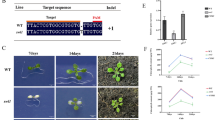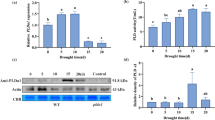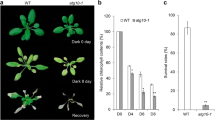Abstract
The cause of the strong non-photochemical fluorescence quenching was examined in maize (Zea mays L.) plants that were treated with lincomycin during the 72 h period of greening. They were deficient in core complexes but seemed to contain the full complement of antennae. The following results were obtained: (1) High F o could not be attributed to the dark reduction of Q A but to the presence of a high amount of not properly organized antenna complexes due to the inhibited synthesis of reaction centres. (2) On illumination fluorescence intensity dropped considerably below F o within 20 s, and reached a steady state still below F o . (3) Slowly relaxing part of non-photochemical quenching was significantly higher than in control plants. (4) De-epoxidation state was constant, and corresponded to the maximal value of the control. (5) Free Lhca1/4 dimers could be detected in all submembrane fractions, including the grana, obtained by digitonin fractionation. (6) Increase in the 679 and 700 nm fluorescence emissions could be attributed to the monomerisation of part of LHCII and to the presence of free Lhca2 or LHCII aggregates, respectively. (7) LHCII or PSII+LHCII and Lhca1/4 interaction may contribute to the increase of long-wavelength fluorescence in the granal fraction. We assume that the elevated fluorescence quenching of monomeric LHCII as well as the interaction between LHCII or PSII+LHCII and Lhca1/4 can be considered as an explanation for the extensive non-photochemical fluorescence quenching in lincomycin treated plants. The permanent presence of zeaxanthin may have contributed to the fast formation of quenching.






Similar content being viewed by others
Abbreviations
- Chl:
-
Chlorophyll
- CA:
-
Connecting antenna
- CC:
-
Core complex
- CP:
-
Chlorophyll protein
- DEPS:
-
De-epoxidation state
- LHC:
-
Light harvesting complex
- NPQ:
-
Non-photochemical quenching calculated by the Stern-Volmer equation
- PAGE:
-
Polyacrylamide gel electrophoresis
- PPFD:
-
Photosynthetic photon flux density
- PS:
-
Photosystem
- qE, qI and qT :
-
Chlorophyll fluorescence quenching related to membrane energisation, photoinhibition and state transition, respectively
- qN and qP:
-
Non-photochemical and photochemical quenching coefficient, respectively
- VAZ:
-
Violaxanthin (V), antheraxanthin (A), zeaxanthin (Z)
References
Abadía J, Abadía A (1993) Iron and plant pigments. In: Barton LL, Hemming BC (eds) Iron chelation in plants and soil microorganisms. Academic, San Diego, pp 327–344
Albertsson P-Å (1995) The structure and function of the chloroplast photosynthetic membrane—a model for the domain organization. Photosynth Res 46:141–149
Aliev JA, Suleimanov SY, Guseinova IM, Ismailov MA, Asadov AA (1993) Effect of specific translation inhibitors on polypeptide composition and spectral characteristics of wheat thylakoid membranes. Photosynthetica 29:361–367
Andersson J, Wentworth M, Walters RG, Howard CA, Ruban AV, Horton P, Jansson S (2003) Absense of the Lhcb1 and Lhcb2 proteins of the light-harvesting complex of Photosystem II—effects on photosynthesis, grana stacking and fitness. Plant J 35:350–361
Bachmann KM, Ebbert V, Adams WW III, Verhoeven AS, Logan BA, Demmig-Adams B (2004) Effects of lincomycin on PSII efficiency, non-photochemical quenching, D1 protein and xanthophyll cycle during photoinhibition and recovery. Funct Plant Biol 31:803–813
Belkhodja R, Morales F, Quílez R, López-Millán A-F, Abadía A, Abadía J (1998) Iron deficiency causes changes in chlorophyll fluorescence due to the reduction in the dark of the Photosystem II acceptor side. Photosynth Res 56:265–276
Boardman NK (1971) Subchloroplast fragments: digitonin method. In: San Pietro A (ed) Methods in enzymology, photosynthesis, part A, vol XXIII. Academic, New York, pp 268–276
Bossmann B, Knoetzel J, Jansson S (1997) Screening of chlorina mutants of barley (Hordeum vulgare L.) with antibodies against light-harvesting proteins of PS I and PS II: absence of specific antenna proteins. Photosynth Res 52:127–136
Buschmann C (1995) Variation of the quenching of chlorophyll fluorescence under different intensities of actinic light in wildtype plants of tobacco and in an aurea mutant deficient of light-harvesting-complex. J Plant Biol 145:245–252
Caffarri S, Frigerio S, Olivieri E, Righetti PG, Bassi R (2005) Differential accumulation of Lhcb gene products in thylakoid membranes of Zea mays plants grown under contrasting light and temperature conditions. Proteomics 5:758–768
Campbell JM, Reusser F, Caskey CT (1979) Specificity of lincomycin action on peptidyl transferase activity. Biochem Biophys Res Commun 90:1032–1038
Croce R, Morosinotto T, Ihalainen JA, Chojnicka A, Breton J, Dekker JP, van Grondelle R, Bassi R (2004) Origin of the 701-nm fluorescence emission of the Lhca2 subunit of higher plant Photosystem I. J Biol Chem 279:48543–48549
Dall’Osto L, Caffarri S, Bassi R (2005) A mechanism of nonphotochemical energy dissipation, independent from PsbS, revealed by a conformational change in the antenna protein CP26. Plant Cell 17:1217–1232
de las Rivas J, Abadía A, Abadía J (1989) A new reversed phase HPLC method resolving all major higher plant photosynthetic pigments. Plant Physiol 91:190–192
Demmig-Adams B, Adams WW III (1996) The role of xanthophyll cycle carotenoids in the protection of photosynthesis. Trends Plant Sci 1:21–26
Desquilbet TE, Duval J-C, Robert B, Houmard J, Thomas JC (2003) In the unicellular red alga Rhodella violacea iron deficiency induces an accumulation of uncoupled LHC. Plant Cell Physiol 44:1141–1151
Doan J-M, Schoefs B, Ruban AV, Etienne A-L (2003) Changes in the LHCI aggregation state during iron repletion in the unicellular red alga Rhodella violacea. FEBS Lett 533:59–62
Duysen M, Huckle L, Mogen K, Freeman T (1987) Chloramphenicol effects on chlorophyll degradation and photosystem I assembly in the chlorina CD3 wheat mutant. Photosynth Res 14:159–169
Ellis RJ (1975) Inhibition of chloroplast protein synthesis by lincomycin and 2-(4-methyl-2,6-dinitroanilino)-n-methylpropionamide. Phytochemistry 17:89–93
Fernandez-Muñoz R, Monro RE, Torres-Pinedo R, Vazquez D (1971) Substrate- and antibiotic-binding sites at the peptidyl-transferase centre of Escherichia coli ribosomes. Eur J Biochem 23:185–193
Fodor F, Cseh E, Varga A, Zárai Gy (1998) Lead uptake, distribution, and remobilization in cucumber. J Plant Nutr 21:1363–1373
Garab Gy, Cseh Z, Kovács L, Rajagopal S, Várkonyi Zs, Wentworth M, Mustárdy L, Dér A, Ruban AV, Papp E, Holzenburg A, Horton P (2002) Light-induced trimer to monomer transition in the main light-harvesting antenna complex of plants:thermo-optic mechanism. Biochemistry 41:15121–15129
Green BR, Durnford DG (1996) The chlorophyll-carotenoid proteins of oxygenic photosynthesis. Annu Rev Plant Physiol Plant Mol Biol 47:685–714
Hiller RG, Pilger TBG, Genge S (1977) Effect of lincomycin on the chlorophyll protein complex I content and photosystem I activity of greening leaves. Biochim Biophys Acta 460:431–444
Horton P, Ruban AV, Rees G, Pascal AA, Noctor G, Young AJ (1991) Control of the light-harvesting function of chloroplast membranes by aggregation of the LHCII chlorophyll-protein complex. FEBS Lett 292:1–4
Horton P, Ruban AV, Walters RG (1996) Regulation of light harvesting in green plants. Annu Rev Plant Physiol Plant Mol Biol 47:655–684
Jansson S, Stefánsson H, Nyström U, Gustafsson P, Albertsson P-Å (1997) Antenna protein composition of PS I and PS II in thylakoid sub-domains. Biochim Biophys Acta 1320:297–309
Josten JJ, Allen PM (1964) The mode of action of lincomycin. Biochem Biophys Res Commun 14:241–244
Laemmli UK (1970) Cleavage of structural proteins during assembly of the head of bacteriophage T4. Nature 227:680–685
Li XP, Björkman O, Shih C, Grossman AR, Rosenquist M, Jansson S, Niyogi KK (2000) A pigment-binding protein essential for regulation of photosynthetic light harvesting. Nature 403:391–395
Melkozernov AN (2001) Excitation energy transfer in photosystem I from oxygenic organisms. Photosynth Res 70:129–153
Morales F, Abadía A, Abadía J (1991) Chlorophyll fluorescence and photon yield of oxygen evolution in iron-deficient sugar beet (Beta vulgaris L.) leaves. Plant Physiol 94:607–613
Morosinotto T, Castelletti S, Breton J, Bassi R, Croce R (2002) Mutation analysis of Lhca1 antenna complex. J Biol Chem 277:36253–36261
Morosinotto T, Caffarri S, Dall’Osto L, Bassi R (2003) Mechanistic aspects of the xanthophyll dynamics in higher plant thylakoids. Physiol Plant 119:347–354
Moseley JL, Allinger T, Herzog S, Hoerth P, Wehinger E, Merchant S, Hippler M (2002) Adaptation to Fe-deficiency requires remodeling of the photosynthetic apparatus. EMBO J 21:6709–6720
Mulo P, Pursiheimo S, Hou C-X, Tyystjärvi T, Aro E-M (2003) Multiple effects of antibiotics on chloroplast and nuclear gene expression. Funct Plant Biol 30:1097–1103
Niyogi KK (2000) Safety valves for photosynthesis. Curr Opin Plant Biol 3:455–460
Okada K, Satoh K, Katoh S (1991) Chloramphenicol is an inhibitor of photosynthesis. FEBS Lett 295:155–158
Porra RJ, Thompson WA, Kriedemann PE (1989) Determination of accurate extinction coefficients and simultaneous equations for assaying chlorophyll a and b extracted with four different solvents: verification of the concentration of chlorophyll standards by atomic absorption spectroscopy. Biochim Biophys Acta 975:384–394
Rochaix J-D (1992) Post-transcriptional steps in the expression of chloroplasts genes. Annu Rev Cell Biol 8:1–28
Ruban AV, Horton P (1992) Mechanism of ΔpH-dependent dissipation of absorbed excitation energy by photosynthetic membranes I. Spectroscopic analysis of isolated light-harvesting complexes. Biochim Biophys Acta 1102:30–38
Ruban AV, Lee PJ, Wentworth M, Young AJ, Horton P (1999) Determination of the stoichiometry and strength of binding of xanthophylls to the photosystem II light harvesting complexes. J Biol Chem 274:10458–10465
Sárvári É, Halász G, Nyitrai P, Láng F (1976) Effect of lincocin treatment on the greening process in bean (Phaseolus vulgaris L.) leaves. Physiol Plant 36:187–192
Sárvári É, Halász G, Török Sz, Láng F (1978) Light-induced fluorescence decay during the greening of normal and lincomycin-treated maize leaves. Planta 141:135–139
Sárvári É, Nyitrai P (1994) Separation of chlorophyll-protein complexes by Deriphat polyacrylamide gradient gel electrophoresis. Electrophoresis 15:1067–1071
Sárvári É, Nyitrai P, Gyüre K (1984) Chlorophyll-protein derivative of the peripheral light-harvesting antenna of photosystem I. Photobiochem Photobiophys 8:229–237
Sárvári É, Szigeti Z, Nyitrai P (1996) Lincomycin induced changes in the organization and fluorescence properties of developing maize thylakoids. Plant Physiol Biochem (special issue), p 109
Scheller HV, Jensen PE, Haldrup A, Lunde C, Knoetzel J (2001) Role of subunits in eukaryotic photosystem I. Biochim Biophys Acta 1507:41–60
Tyystjärvi E, Aro EM (1996) The rate constant of photoinhibition, measured in lincomycin-treated leaves, is directly proportional to light intensity. Proc Nat Acad Sci USA 93:2213–2218
Vijayan P, Browse J (2002) Photoinhibition in mutants of Arabidopsis deficient in thylakoid unsaturation. Plant Physiol 129:876–885
Wentworth M, Ruban AV, Horton P (2004) The functional significance of the monomeric and trimeric states of the photosystem II light harvesting complexes. Biochemistry 43:501–509
Zhang H, Goodman HM, Jansson S (1997) Antisense inhibition of the photosystem I antenna protein Lhca4 in Arabidopsis thaliana. Plant Physiol 115:1525–1531
Zhang S, Scheller HV (1999) Light-harvesting complex II binds to several small subunits of photosystem I. J Biol Chem 279:3180–3187
Acknowledgements
We are grateful to M. Barón and B. Böddi for valuable discussions. The authors thank the skilful assistance of Zsuzsanna Ostorics. This work was financially supported by the OTKA (T 043646) grant.
Author information
Authors and Affiliations
Corresponding author
Rights and permissions
About this article
Cite this article
Gáspár, L., Sárvári, É., Morales, F. et al. Presence of ‘PSI free’ LHCI and monomeric LHCII and subsequent effects on fluorescence characteristics in lincomycin treated maize. Planta 223, 1047–1057 (2006). https://doi.org/10.1007/s00425-005-0149-0
Received:
Accepted:
Published:
Issue Date:
DOI: https://doi.org/10.1007/s00425-005-0149-0




